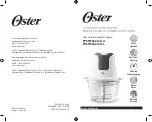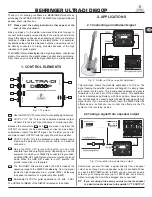
OPTIMOD-AM DIGITAL
OPERATION
3-7
Quality in the Broadcast Facility
(an Orban publication downloadable from
ftp.orban.com) for a discussion of how to improve source quality.
A high-quality monitor system is essential. To modify your air sound effectively, you
must be able to
hear
the results of your adjustments.
Maintaining
Audio Quality in
the Broadcast Facility
also contains a detailed discussion of how to efficiently create
an accurate monitoring environment.
Monitor Rolloff Filter
The response curve of the monitor system is as important as its quality. Because the
studio monitor typically has a flat response, and because OPTIMOD-AM's output is
ordinarily significantly pre-emphasized, the sound that emerges from the monitor
will be shrill and unpleasant if the supplied Monitor Rolloff Filter is not installed be-
fore the monitor amplifier.
The response of this filter can be jumpered to emulate an “ideal” NRSC radio or to
complement the frequency response of the HF equalizer with its
HF
C
URVE
set to 0.
Because there are so few radios with anything approaching NRSC response (even in
NRSC countries), we believe that it is wiser to jumper the Monitor Rolloff Filter for
non-NRSC operation in almost all situations. If this 18dB/octave rolloff is used, the
response of this filter is approximately complementary to the frequency response of
the HF Equalizer with
HF
C
URVE
set to 0. (See
on page 3-21 and
on page 2-5.). Because the filter shelves off at high frequencies (to match the re-
ceiver equalization) instead of continuing to roll off like a real radio, the monitor
will sound somewhat brighter than a real radio and cannot be used to make final
subjective adjustments of OPTIMOD-AM setup controls. Nevertheless, it is suitable as
a reference for assessing quality, as it will clearly reveal distortion and other prob-
lems that may arise in the plant. Indeed, it will be somewhat more revealing than a
real radio.
Reference Radios for the Processing
However, do not rely on your monitor alone for subjectively evaluating your air
sound. It is a good idea to develop a set of “reference radios” with which you are
familiar and which are similar to those used by a majority of your audience. Too of-
ten, just
one
radio (typically the Program Director or General Manager's car radio) is
used to evaluate air sound. Unless all of your listeners happen to have the same ra-
dio, this approach will not give an accurate indication of what your audience is hear-
ing.
Based on their high-frequency response, AM radios can be divided into three groups:
Group 1:
Wideband AM radios, typically with response that approximately fol-
lows the recommended NRSC “modified 75µs” deemphasis to 5 kHz or above.
There are very few such radios available.
Group 2:
Radios with a response down 3dB at approximately 2 kHz, with a gen-
tle rolloff above that frequency. Because the rolloff is gentle, preemphasis can
be used to brighten the sound.
Group 3:
Radios with a response down 3dB at approximately 2 kHz, with a very
Summary of Contents for OPTIMOD-AM 9300
Page 1: ...Operating Manual OPTIMOD AM 9300 Digital Audio Processor Version 2 0 Software...
Page 7: ...Operating Manual OPTIMOD AM 9300 Digital Audio Processor Version 2 0 Software...
Page 178: ...3 46 OPERATION ORBAN MODEL 9300...
Page 200: ......
Page 221: ...OPTIMOD AM DIGITAL TECHNICAL DATA 6 21...
Page 222: ...6 22 TECHNICAL DATA ORBAN MODEL 9300 CONTROL BOARD PARTS LOCATOR...
Page 228: ...6 28 TECHNICAL DATA ORBAN MODEL 9300...
Page 229: ...OPTIMOD AM DIGITAL TECHNICAL DATA 6 29 I O DSP BOARD LEFT AND RIGHT ANALOG INPUTS...
Page 230: ...6 30 TECHNICAL DATA ORBAN MODEL 9300 I O DSP BOARD ANALOG OUTPUTS...
Page 231: ...OPTIMOD AM DIGITAL TECHNICAL DATA 6 31...
Page 238: ...6 38 TECHNICAL DATA ORBAN MODEL 9300 FRONT VIEW REAR VIEW FRONT PANEL PARTS LOCATOR DIAGRAM...
















































